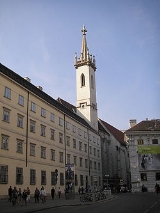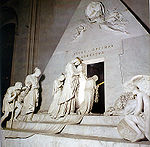
Augustinerkirche
Encyclopedia
The Augustinian Church in Vienna
is a parish church located on Josefsplatz, next to the Hofburg, the winter palace of the Habsburg
dynasty in Vienna
. Originally built in the 14th century as the parish church of the imperial court of the Habsburg
s, the harmonious Gothic
interior was added in the 18th century. Its official name is St. Augustine's Church, although the Viennese always called it the Augustinian Church.
(Friedrich der Schöne) founded this church with a cloister
for the Augustinian friars.
In1634, the Augustinerkirche became the parish church of the imperial church. As imperial church, many Habsburg
weddings took place there, including the wedding of Archduchess (and future Empress) Maria Theresa
in 1736 to Duke Francis of Lorraine
, the wedding of Archduchess Marie Louise
in 1810 to Emperor Napoleon Bonaparte
of France, and the wedding of Emperor Franz Joseph
in 1854 to Duchess Elisabeth in Bavaria
.
A functioning monastery of six black-robed Augustinian monks remains, serving the needs of the parish.
was built under architect Dietrich Landtner from 1330 to 1339, but not consecrated until 1 November 1349. As the nearby Hofburg expanded, the Augustinerkirche gradually became engulfed by it and today is a part of the complex. Although inconspicuous from the outside, the inside is more ornate. During the reign of Emperor Joseph II
, 18 side altars were removed in 1784 when the church was restored in the gothic
style. A new side altar was added in 2004, dedicated to Emperor Karl I of Austria
(1887–1922) who is on the path to being recognized as a saint
by the Roman Catholic Church.
rulers, while their bodies are kept in the Imperial Crypt
. Herzgruft contains the hearts of 54 members of the imperial family.

sculpted by Antonio Canova
, in 1805.
conducted the Mass he composed in F there, and Anton Bruckner
’s Mass in F minor had its world premiere in the church.
In the 21st century, the church is known to host high quality sacred music concerts, particularly for its weekly Sunday High mass with full orchestra and choir. The church also has two organs.
Vienna
Vienna is the capital and largest city of the Republic of Austria and one of the nine states of Austria. Vienna is Austria's primary city, with a population of about 1.723 million , and is by far the largest city in Austria, as well as its cultural, economic, and political centre...
is a parish church located on Josefsplatz, next to the Hofburg, the winter palace of the Habsburg
Habsburg
The House of Habsburg , also found as Hapsburg, and also known as House of Austria is one of the most important royal houses of Europe and is best known for being an origin of all of the formally elected Holy Roman Emperors between 1438 and 1740, as well as rulers of the Austrian Empire and...
dynasty in Vienna
Vienna
Vienna is the capital and largest city of the Republic of Austria and one of the nine states of Austria. Vienna is Austria's primary city, with a population of about 1.723 million , and is by far the largest city in Austria, as well as its cultural, economic, and political centre...
. Originally built in the 14th century as the parish church of the imperial court of the Habsburg
Habsburg
The House of Habsburg , also found as Hapsburg, and also known as House of Austria is one of the most important royal houses of Europe and is best known for being an origin of all of the formally elected Holy Roman Emperors between 1438 and 1740, as well as rulers of the Austrian Empire and...
s, the harmonious Gothic
Gothic architecture
Gothic architecture is a style of architecture that flourished during the high and late medieval period. It evolved from Romanesque architecture and was succeeded by Renaissance architecture....
interior was added in the 18th century. Its official name is St. Augustine's Church, although the Viennese always called it the Augustinian Church.
History
In 1327, Duke Frederick the HandsomeFrederick I of Austria (Habsburg)
Frederick the Handsome or the Fair , from the House of Habsburg, was Duke of Austria and Styria from 1308 as Frederick I as well as King of Germany from 1314 as Frederick III until his death.-Biography:He was the second son of King Albert I of Germany with his wife Elisabeth of...
(Friedrich der Schöne) founded this church with a cloister
Cloister
A cloister is a rectangular open space surrounded by covered walks or open galleries, with open arcades on the inner side, running along the walls of buildings and forming a quadrangle or garth...
for the Augustinian friars.
In1634, the Augustinerkirche became the parish church of the imperial church. As imperial church, many Habsburg
Habsburg
The House of Habsburg , also found as Hapsburg, and also known as House of Austria is one of the most important royal houses of Europe and is best known for being an origin of all of the formally elected Holy Roman Emperors between 1438 and 1740, as well as rulers of the Austrian Empire and...
weddings took place there, including the wedding of Archduchess (and future Empress) Maria Theresa
Maria Theresa of Austria
Maria Theresa Walburga Amalia Christina was the only female ruler of the Habsburg dominions and the last of the House of Habsburg. She was the sovereign of Austria, Hungary, Croatia, Bohemia, Mantua, Milan, Lodomeria and Galicia, the Austrian Netherlands and Parma...
in 1736 to Duke Francis of Lorraine
Francis I, Holy Roman Emperor
Francis I was Holy Roman Emperor and Grand Duke of Tuscany, though his wife effectively executed the real power of those positions. With his wife, Maria Theresa, he was the founder of the Habsburg-Lorraine dynasty...
, the wedding of Archduchess Marie Louise
Marie Louise, Duchess of Parma
Marie Louise of Austria was the second wife of Napoleon I, Emperor of the French and later Duchess of Parma...
in 1810 to Emperor Napoleon Bonaparte
Napoleon I of France
Napoleon Bonaparte was a French military and political leader during the latter stages of the French Revolution.As Napoleon I, he was Emperor of the French from 1804 to 1815...
of France, and the wedding of Emperor Franz Joseph
Franz Joseph I of Austria
Franz Joseph I or Francis Joseph I was Emperor of Austria, King of Bohemia, King of Croatia, Apostolic King of Hungary, King of Galicia and Lodomeria and Grand Duke of Cracow from 1848 until his death in 1916.In the December of 1848, Emperor Ferdinand I of Austria abdicated the throne as part of...
in 1854 to Duchess Elisabeth in Bavaria
Elisabeth of Bavaria
Elisabeth of Austria was the spouse of Franz Joseph I, and therefore both Empress of Austria and Queen of Hungary. She also held the titles of Queen of Bohemia and Croatia, among others...
.
A functioning monastery of six black-robed Augustinian monks remains, serving the needs of the parish.
Interior
The naveNave
In Romanesque and Gothic Christian abbey, cathedral basilica and church architecture, the nave is the central approach to the high altar, the main body of the church. "Nave" was probably suggested by the keel shape of its vaulting...
was built under architect Dietrich Landtner from 1330 to 1339, but not consecrated until 1 November 1349. As the nearby Hofburg expanded, the Augustinerkirche gradually became engulfed by it and today is a part of the complex. Although inconspicuous from the outside, the inside is more ornate. During the reign of Emperor Joseph II
Joseph II, Holy Roman Emperor
Joseph II was Holy Roman Emperor from 1765 to 1790 and ruler of the Habsburg lands from 1780 to 1790. He was the eldest son of Empress Maria Theresa and her husband, Francis I...
, 18 side altars were removed in 1784 when the church was restored in the gothic
Gothic architecture
Gothic architecture is a style of architecture that flourished during the high and late medieval period. It evolved from Romanesque architecture and was succeeded by Renaissance architecture....
style. A new side altar was added in 2004, dedicated to Emperor Karl I of Austria
Karl I of Austria
Charles I of Austria or Charles IV of Hungary was the last ruler of the Austro-Hungarian Empire. He was the last Emperor of Austria, the last King of Hungary, the last King of Bohemia and Croatia and the last King of Galicia and Lodomeria and the last monarch of the House of Habsburg-Lorraine...
(1887–1922) who is on the path to being recognized as a saint
Saint
A saint is a holy person. In various religions, saints are people who are believed to have exceptional holiness.In Christian usage, "saint" refers to any believer who is "in Christ", and in whom Christ dwells, whether in heaven or in earth...
by the Roman Catholic Church.
Chapels
The Loreto Chapel, to the right of the main altar, holds the silver urns containing the hearts of HabsburgHabsburg
The House of Habsburg , also found as Hapsburg, and also known as House of Austria is one of the most important royal houses of Europe and is best known for being an origin of all of the formally elected Holy Roman Emperors between 1438 and 1740, as well as rulers of the Austrian Empire and...
rulers, while their bodies are kept in the Imperial Crypt
Imperial Crypt, Vienna
The Imperial Crypt in Vienna, Austria lies below the Capuchin Church and monastery founded in 1618 and dedicated in 1632. It is on the Neuer Markt square of the Innere Stadt, near the imperial Hofburg Palace...
. Herzgruft contains the hearts of 54 members of the imperial family.

Tomb of Maria Christina
Notable among the church's monuments is the memorial to Archduchess Maria Christina of AustriaArchduchess Maria Christina, Duchess of Teschen
Maria Christina, Duchess of Teschen , called "Mimi", was the fourth daughter and fifth child of Maria Theresa of Austria and Francis I, Holy Roman Emperor...
sculpted by Antonio Canova
Antonio Canova
Antonio Canova was an Italian sculptor from the Republic of Venice who became famous for his marble sculptures that delicately rendered nude flesh...
, in 1805.
Sacred music
Composer Franz SchubertFranz Schubert
Franz Peter Schubert was an Austrian composer.Although he died at an early age, Schubert was tremendously prolific. He wrote some 600 Lieder, nine symphonies , liturgical music, operas, some incidental music, and a large body of chamber and solo piano music...
conducted the Mass he composed in F there, and Anton Bruckner
Anton Bruckner
Anton Bruckner was an Austrian composer known for his symphonies, masses, and motets. The first are considered emblematic of the final stage of Austro-German Romanticism because of their rich harmonic language, complex polyphony, and considerable length...
’s Mass in F minor had its world premiere in the church.
In the 21st century, the church is known to host high quality sacred music concerts, particularly for its weekly Sunday High mass with full orchestra and choir. The church also has two organs.

